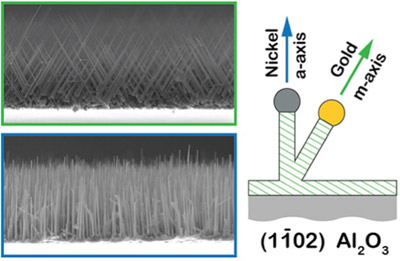
Scientific Achievement
A team of multidisciplinary researchers at the Berkeley Lab’s Molecular Foundry used catalyst composition to control the crystallographic growth of GaN nanowires
Significance and Impact
Manipulating GaN nanostructures offers the ability to custom design bulk material properties in unique ways, potentially leading to new applications and improved performance in next generation light emitting devices
Research Details
- Nanowires are often synthesized with the help of small metallic catalyst particles that give rise to defect-free nanowires that grow along specific crystallographic directions
- It was found that a bimetallic catalyst – a gold–nickel alloy – can be used to selectively control the crystallographic growth direction of the nanowire along two distinct nonpolar axes
- Certain conditions were found to change the catalyst composition mid-growth resulting in structures with segments in two distinct orientations
- Due to their distinct surfaces, the optical properties were shown to vary depending on the nanowire’s growth direction

